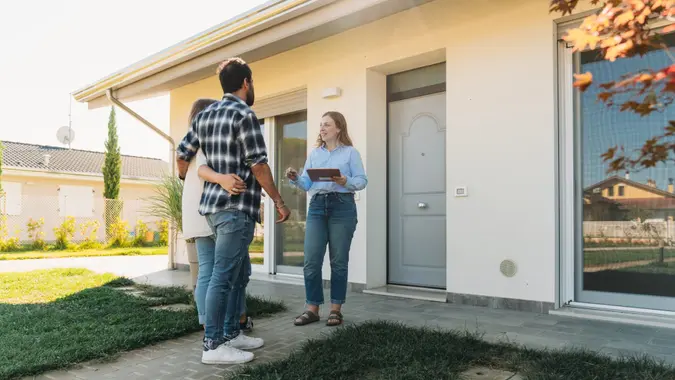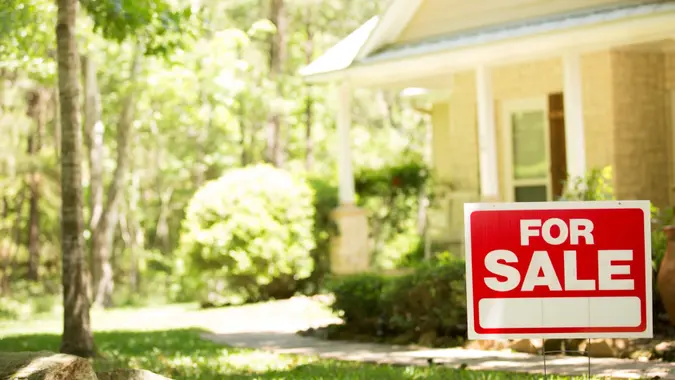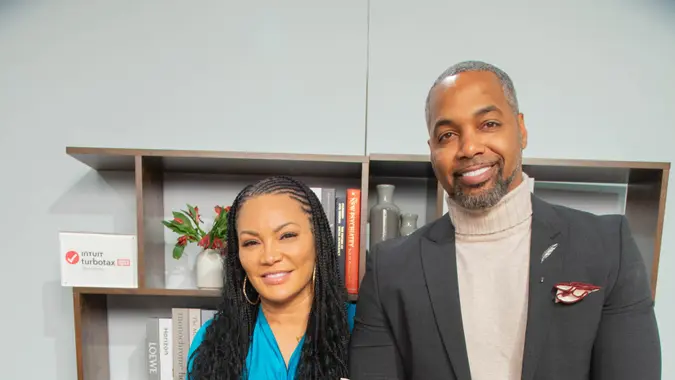Home Loans for Bad Credit: Tips to Get Approved and Own a Home

Commitment to Our Readers
GOBankingRates' editorial team is committed to bringing you unbiased reviews and information. We use data-driven methodologies to evaluate financial products and services - our reviews and ratings are not influenced by advertisers. You can read more about our editorial guidelines and our products and services review methodology.

20 Years
Helping You Live Richer

Reviewed
by Experts

Trusted by
Millions of Readers
Your credit history is one of the most important factors lenders consider when deciding whether to approve you for a mortgage loan.
But if you’re dreaming of becoming a homeowner, it’s not necessarily out of reach — even if you have a low credit score. There are several home loans for bad credit and certain assistance programs that could help with some of the upfront costs.
In this guide, we’ll break down how to buy a house with bad credit, some tips for improving your score and alternative paths to homeownership.
Understanding Bad Credit
What is a Credit Score?
A credit score rates a borrower’s creditworthiness, typically between 300 and 850. It factors in several aspects of your financial situation, including:
- Payment history
- Unpaid debt
- Credit age
- Number of accounts
- Credit mix
- Hard inquiries
A higher credit score can show responsibility with money, making qualifying for loans and getting lower interest rates easier.
Factors Leading to Bad Credit
Several factors may lower your credit score. Here are some of the most common causes:
- Missed or late payments
- High credit card balances
- Defaults, charge-offs or accounts in collections
- Bankruptcy or foreclosure
- Limited or no credit history
- Several hard inquiries or new accounts
These marks on your credit report could indicate risky financial behavior, which may make lenders hesitant to lend you money, limiting you to home loans for bad credit.
How Bad Credit Affects Home Buying
So, can you buy a house with bad credit? The answer is yes, but you might encounter a few challenges, like:
- A higher interest rate on your mortgage
- Fewer available loan options
- Larger down payment requirements
- Limits to how much you can borrow
With bad credit, you might have a harder time qualifying for a mortgage and could pay substantially more over the life of your loan.
Assessing Your Financial Situation
When looking at how to buy a house with bad credit, evaluating your finances will help you know what to expect when applying for a mortgage.
Reviewing Your Credit Report
First, check your credit score and history. You can visit AnnualCreditReport.com to request a free report from each of the three credit bureaus (Equifax, Experian and TransUnion).
Review the reports for errors or outdated information. If you find mistakes, contact all three credit bureaus with the proper documentation to correct them. You should also look for negative marks you can fix, like accounts in collections.
Calculating Your Debt-to-Income Ratio
Along with your credit report, lenders also check your debt-to-income (DTI) ratio to see how much additional debt you can handle.
To calculate your DTI ratio, add up your monthly payments toward debt and divide them by your gross monthly income:
DTI ratio = Total monthly debt payments ÷ Gross monthly income
Most lenders prefer a DTI ratio below 43%. If your DTI is above that, paying off some of your debt may improve your loan eligibility.
Building Cash Reserves
There are a lot of expenses that come with buying a house. Here are a few things to save for:
- Your down payment (preferably 20% to avoid private mortgage insurance, also known as PMI)
- Closing costs
- Moving expenses
- An emergency fund (at least three to six months’ expenses)
Having substantial cash reserves also shows financial responsibility, which could strengthen your mortgage application.
Exploring Loan Options for Bad Credit
When exploring how to buy a house with bad credit, research different types of mortgages, including:
FHA Loans
Backed by the Federal Housing Administration, FHA loans have easier qualifying requirements, making them one of the best home loans for bad credit.
With 10% down, you can qualify for this loan with a credit score of 500 to 579. If your score is 580 or higher, you can buy with a 3.5% down payment.
One disadvantage to FHA loans is that most require a mortgage insurance premium.
VA Loans
You qualify for a Veterans Affairs (VA) loan if you’re one of the following:
- An active-duty service member
- A veteran
- A member of the National Guard
- A reserve member
- The surviving spouse of a veteran
- The spouse of a veteran who’s missing in action or a prisoner of war
No down payment is required to buy a home with a VA loan. However, you may have to pay a VA funding fee.
Although the VA doesn’t impose a minimum credit score, most lenders require 620 or higher.
USDA Loans
The U.S. Department of Agriculture backs USDA loans to help lower-income borrowers with credit issues buy a home with no down payment.
The USDA has no set minimum credit requirements, but lenders often require a score of 580 to 620. Eligibility, however, also depends on the home’s location since USDA loans are limited to properties in specific rural areas.
Subprime Mortgages
If you don’t qualify for the loan options above and you’re still wondering how to buy a house with bad credit, subprime mortgages are another loan type designed for home buyers with low credit scores.
Usually, these lenders charge higher interest rates to offset the risk of providing funds to subprime borrowers. These mortgages might also come with adjustable interest rates or charge prepayment penalties.
While it may be easier to qualify for subprime mortgages, they can be very expensive in the long run, so it’s best to explore all other options first.
Improving Your Credit Score
If your credit score is low due to financial mistakes you’ve made in the past, your goal should be to boost it so you can not only qualify for a loan but get a competitive interest rate as well.
Here’s what you can do to improve your credit score:
Timely Bill Payments
Your payment history affects your credit more than any other factor, so paying your bills on time is one of the best ways to improve your score.
If you’re having trouble hitting the due dates on your bills, add them to a calendar app on your phone and set reminders. You can also set up autopay, so the money will automatically come out of your account.
Reducing Outstanding Debts
Paying down debt, starting with accounts in collection, will reduce your DTI and might increase your credit score. Your credit utilization — the percentage of credit you’re using vs. what you have access to — should stay below 30% but ideally be under 10%.
When paying off your debt, try either the avalanche method (focus on highest-interest debts first) or the snowball method (tackle debts with the lowest balances first). Debt consolidation could also help you lower your interest rate and monthly payments.
Avoiding New Credit Inquiries
Applying for new lines of credit could signal to lenders that you’re going through financial hardships and need access to money. Hard inquiries can also temporarily lower your credit score.
This is why you should avoid applying for new loans or credit cards right before or during the home-buying process.
Saving for a Larger Down Payment
Benefits of a Larger Down Payment
A larger down payment will improve your loan-to-value (LTV) ratio — your mortgage loan amount divided by the appraised value of the home you’re buying. The lower the LTV, the less risky the loan will seem to the lender, as you’ll have more equity in your new home.
If your down payment is at least 20%, you won’t have to pay PMI, which is insurance that protects the lender if you don’t pay your mortgage. With a large down payment, you might also qualify for a lower interest rate.
Tips to Save Money Quickly
One of the smartest moves when figuring out how to buy a house with bad credit is saving as much as possible. Here are some quick tips that can help:
- Make a budget: A budget lets you stay on track with your savings. Look at your past financial statements to get a sense of your expenses. Then, set limits on your spending for the upcoming month.
- Track your spending: After making your budget, track your expenses throughout the month to prevent overspending. Try to cut expenses so you can save more.
- Increase your income: Find ways to bring in more money each month, such as picking up more hours at work or starting a side hustle. A side gig could also strengthen your mortgage application by increasing your income and decreasing your DTI.
- Open a high-yield savings account (HYSA): Many online banks offer around 3% to 4% APY on their savings accounts. With a HYSA, you can earn compound interest and grow your savings faster.
- Automate your savings: Set up automatic, recurring transfers to savings when you get paid. This can prevent the temptation to spend your whole paycheck and ensures you hit your savings goal each month.
Down Payment Assistance Programs
Down payment assistance (DPA) can play a major role in how to buy a house with bad credit by reducing some of your upfront expenses.
You may find these programs in the form of grants or loans through housing agencies and nonprofit organizations at the local level. If you want to look for a DPA program near you, try contacting your state’s HFA, visiting your city and county website or asking your loan officer.
You may need to meet certain eligibility criteria, such as being a first-time home buyer or meeting income requirements.
Seeking Professional Guidance
Working with Mortgage Brokers
A mortgage broker will shop multiple lenders for you to compare different rates and terms. They may be able to help you find the best lenders for bad credit home loans.
Brokers can also explain different loan options so you can make more informed decisions and know what you’re signing up for.
Consulting Financial Advisors
A financial advisor may help you improve your finances overall. They can support you in building a budget, saving money and making a plan for debt repayment.
With this personalized guidance, you might be able to improve your credit score and you specific advice on how to get a home loan with bad credit.
Attending Homebuyer Education Courses
A homebuyer education course can teach you about different aspects of homeownership, including:
- Saving for a down payment
- Shopping for a home
- Financing
- Maintaining the property
You may have to take one of these courses to qualify for assistance programs, like DPA or certain government-backed loans.
Considering Alternative Paths to Homeownership
Rent-to-Own Agreements
A rent-to-own agreement lets you lease a property with the opportunity to buy it at the end of the contract. Part of your monthly rent may go toward a down payment on the home.
With this option, you have time to build your credit score and save money before applying for a mortgage. However, review the terms carefully, including the purchase price, fees, maintenance requirements and what happens if you decide not to buy.
Co-signing with a Trusted Partner
Another strategy for how to buy a house with bad credit is asking a relative or close friend with good credit to cosign, which may make qualifying for a mortgage easier.
The co-signer legally agrees to be responsible for the loan, so they’ll be on the hook if you default on the mortgage. Any late or missed payments will hurt both your and the cosigner’s credit.
Purchasing a Less Expensive Property
Choosing a more affordable home could also make it easier to get approved for a mortgage since it’s less risky for the lender. It can also lower your monthly payments, which might make them more manageable.
If you have a lot saved, you could put a larger down payment on the property, which could get you a lower interest rate.
Final Thoughts to GO: You Can Still Become a Homeowner, Even With Bad Credit
Buying a house with bad credit might feel overwhelming, but it’s entirely possible with the right strategy and tools. Remember, programs like FHA, VA and USDA loans exist specifically to help buyers facing credit challenges. Improving your credit — even slightly — can open up even more possibilities, like lower interest rates and better loan terms.
Start by reviewing your credit report for errors, lowering your existing debt, and saving up for a larger down payment if you can. Connect with reputable lenders or mortgage brokers who specialize in working with buyers who have less-than-perfect credit.
Ready to take the next step toward homeownership? Check with your bank or a local lender today to see what mortgage options are available to you. You can also learn more about improving your credit score quickly or compare loan options tailored specifically to your situation.
You’re closer than you think to getting the keys to your new home — so start exploring your options today.
FAQ
Here are some common and frequently asked questions when it comes to buying a house with bad credit:- Can I buy a house with a credit score below 600?
- You might qualify for a government-backed mortgage (like an FHA or USDA loan) or a subprime mortgage. However, lenders often also require a low DTI and steady income.
- How long does it take to improve my credit score?
- Some improvements could show up in 30 days, but fixing bad credit could take several months or longer.
- Are there specific lenders that specialize in bad credit mortgages?
- Yes, there are lenders specializing in low-credit borrowers. However, they may charge higher interest rates.
The information is accurate as of April 1, 2025.
Editorial Note: This content is not provided by any entity covered in this article. Any opinions, analyses, reviews, ratings or recommendations expressed in this article are those of the author alone and have not been reviewed, approved or otherwise endorsed by any entity named in this article.
Our in-house research team and on-site financial experts work together to create content that’s accurate, impartial, and up to date. We fact-check every single statistic, quote and fact using trusted primary resources to make sure the information we provide is correct. You can learn more about GOBankingRates’ processes and standards in our editorial policy.
- CFPB "What is a credit score?"
- Experian "What Affects Your Credit Scores?"
- Equifax "Why Should I Check my Credit Reports and Credit Scores?"
- Experian "How to Buy a House With Bad Credit"
- AnnualCreditReport.com "website"
- Experian "How to Calculate Your Debt-to-Income Ratio"
 Written by
Written by  Edited by
Edited by 

























